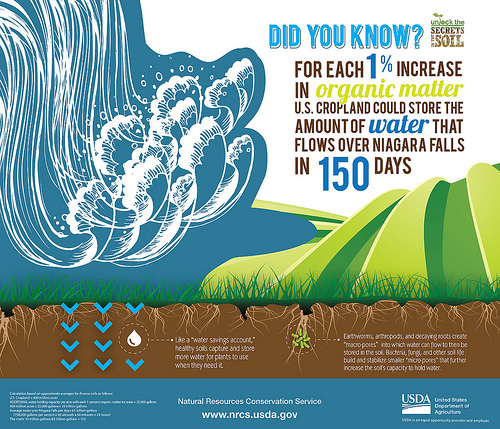
A Hedge against Drought: Why Healthy Soil Is ‘Water in the Bank’
While most look to the sky for drought relief, an increasing number of farmers are looking to the soil. And for good reason: Healthy soils capture and store much more water – which can come in handy during dry spells.
Through its “Unlock the Secrets in the Soil” campaign, USDA’s Natural Resources Conservation Service is leading the effort to get more farmers and ranchers to adopt soil health management systems for a wide range of on- and off-farm benefits – including drought resiliency.
May 12, 2015 | Source: USDA | by Ron Nichols, Natural Resources Conservation Service
While most look to the sky for drought relief, an increasing number of farmers are looking to the soil. And for good reason: Healthy soils capture and store much more water – which can come in handy during dry spells.
Through its “Unlock the Secrets in the Soil” campaign, USDA’s Natural Resources Conservation Service is leading the effort to get more farmers and ranchers to adopt soil health management systems for a wide range of on- and off-farm benefits – including drought resiliency.
So what’s the water-banking secret in healthy soil?
“Organic matter and living organisms provide the foundation for soil to function properly, allowing it to take in, store and deliver water to plants, among many other benefits,” said NRCS’ Soil Health Division Director, Dr. Bianca Moebius-Clune.
“Organic matter causes soil to form stable soil aggregates, or crumbs,” she said. “With better soil structure, infiltration of water into the soil improves, which allows the entire soil profile to take in and hold more water when it rains.” Healthy soil acts much like a sponge, with its ability to absorb and hold much of its volume in water.
The difference between healthy, stable soil and degraded, unstable soil can be seen dramatically in NRCS’ soil stability test video demonstration.
In healthy soil, earthworms, arthropods and decaying roots create “macro-pores” into which water can flow to then be stored in the soil. “Bacteria, fungi and other soil life build and stabilize smaller ‘micro-pores’ that further increase the soil’s capacity to hold water,” Moebius-Clune said.
Contrary to conventional thought, plowing or tillage actually reduces the capacity of the soil to receive and hold water over time, according to Moebius-Clune. “That’s because tillage destroys soil aggregates and the biologically produced glues that hold soil aggregates together,” she said. “This results in the collapse of those aggregates and the pores between them, which leads to compaction, crusting, increased run-off and downstream flooding, all of which decreases the amount of water that enters the soil profile to be stored and used by crops.”
